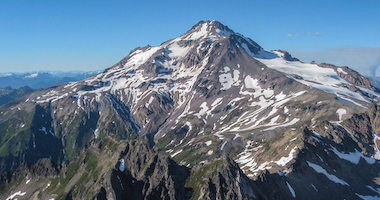The simple routines you establish—such as taking care of yourself, organizing your gear, and checking in with your tent mates—can make all the difference in maintaining a positive mindset.
Types of Days on McKinley
Life on McKinley can be broken down into three main types of days: Carry days, Move days, and Rest days.
Carry Days: These days are dedicated to hauling gear, food, and fuel up to higher elevations to cache for later use. You'll typically spend 5-6 hours ascending to the cache site, then about an hour digging a hole deep enough to protect your supplies from the notorious McKinley ravens. After caching, they return to camp with lighter loads, making the descent quicker and less strenuous.
Move Days: On move days, the entire camp is relocated, including tents and equipment not cached earlier. Move days are intense, often involving 6-8 hours of hiking with heavier packs, followed by the physical labor of setting up a new camp. Tasks include building tent platforms, digging out a cooking area, and melting snow for water. These days start early, around 6:30 or 7 a.m., and often stretch late into the evening, with climbers settling into their new camp around 10:30 or 11 p.m.
Rest Days: These are crucial for recovery. You might use back carries to retrieve cached items, which still involves physical effort but is less demanding than carry or move days. Rest days allow longer, more relaxed meals, napping, reading, or simply socializing with other climbers. If weather and conditions permit, these days are used to review necessary skills or take short acclimatization hikes.
Finding Routine and Settling In
Daily Routines: Establishing a consistent routine is vital for the mental and physical well-being of McKinley. Simple rituals such as checking in with your tent mates, maintaining your gear, and setting aside time for personal hygiene can bring a sense of normalcy. According to RMI Guide Seth Burns, “Life at camp is about keeping it light and taking care of yourself and your teammates.” Climbers can stay grounded and focused throughout the expedition by concentrating on small, manageable tasks.
Connecting with Home: While staying in touch with friends and family is comforting, it’s also important not to overdo it. Too much contact can lead to homesickness and distract from the experience. Find balance by setting aside specific times, usually in the evening, to turn on your InReach device and send a few messages. This approach helps you stay connected without detracting from the camaraderie and beauty of life on McKinley.

Sleep and Rest
Quality sleep on McKinley is crucial, yet it can be challenging due to the cold temperatures and constant daylight. Here are some strategies to help climbers get the rest they need.
Darkness: Falling asleep can be difficult with nearly 24 hours of daylight during the climbing season. Using a dark-colored buff or eye mask to cover your eyes can help simulate darkness and signal your brain that it’s time to sleep.
Sleep System: A reliable sleep system is essential. This includes a sleeping bag rated for cold temperatures, typically -20°F to -40°F, depending on your tolerance. Pair this with an inflatable sleeping pad with a high R-value for insulation, complemented by a foam pad underneath to prevent heat loss to the snow. Finding the right balance between warmth and comfort is key, and testing your setup before the expedition is advisable. For more information on McKinley sleep systems, check out our Gear and Apparel Guide.
Quiet: The bustling noise of a busy camp, snoring tent mates, or teams moving through camp can disrupt sleep. Earplugs or noise-canceling headphones can provide much-needed quiet. A small music player (like your smartphone) or white noise app can also help drown out background noise, aiding a deeper, more restful sleep.
"Quality sleep in the Alaska Range can be tricky at first...That being said, there are a couple of strategies I’ve found to be really helpful, and I often have some of my most restful nights of sleep all year on Denali trips."
Henry Coppolillo, RMI Expeditions Guide
Coping with the Challenges
Managing Stress: McKinley's unpredictable weather and physical demands can be stressful. One mental strategy is to focus on what you can control and not fixate on the summit. Taking one day at a time, celebrating small achievements, and maintaining a positive attitude can significantly impact your overall experience.
Dealing with Weather Delays: Extended weather delays are a common challenge on McKinley. Being prepared with plenty of entertainment options, like books, movies, or games, can help pass the time. Developing a daily routine, even when stuck in the tent, can also help maintain morale and prevent restlessness.
Bathroom Routine: One of the more unique aspects of mountain life on McKinley is the bathroom routine. Climbers use Clean Mountain Cans (CMCs) the Park Service provides for solid waste. Camps are equipped with designated bathroom areas, and maintaining hygiene is critical. Bringing personal hand sanitizer and keeping it accessible is essential, especially when water for washing hands is scarce. Below is a breakdown of what using a CMC is like:
- Setting Up the CMC: We position the Clean Mountain Can (CMC) on a pedestal, mimicking a standard toilet height, making it more comfortable to use. This helps maintain a sense of normalcy while using the facilities.
- Establishing Pee Holes: We create separate designated areas near the CMC for men’s and women’s pee holes. This separation helps maintain cleanliness and efficiency in the camp's bathroom routine.
- Monitoring CMC Usage: With a team of twelve, a single CMC typically fills up every 1-2 days. Regularly check the can's capacity to avoid overfilling.
- Handling Full CMCs: Once a CMC is full, we tie off the bag securely, screw on the top, and cache the full can at the camp. When descending the mountain, these cans will be collected and carried back to the airstrip for proper disposal.
- Prioritizing Cleanliness and Hygiene: Maintaining hygiene is crucial due to the lack of handwashing facilities. Guides provide large bottles of hand sanitizer for team use. Each team member should also carry a small personal bottle of hand sanitizer, ensuring easy access after using the bathroom and before meals.
"There is so much that is out of our control on an extended expedition that taking care of what you can control brings greater comfort and less stress..."
Seth Burns, RMI Expeditions Guide
Life on McKinley is a blend of challenge, camaraderie, and moments of awe-inspiring beauty. By embracing the routines, supporting each other, and finding joy in the little things, climbers can thrive in one of the most extreme environments on Earth.
















